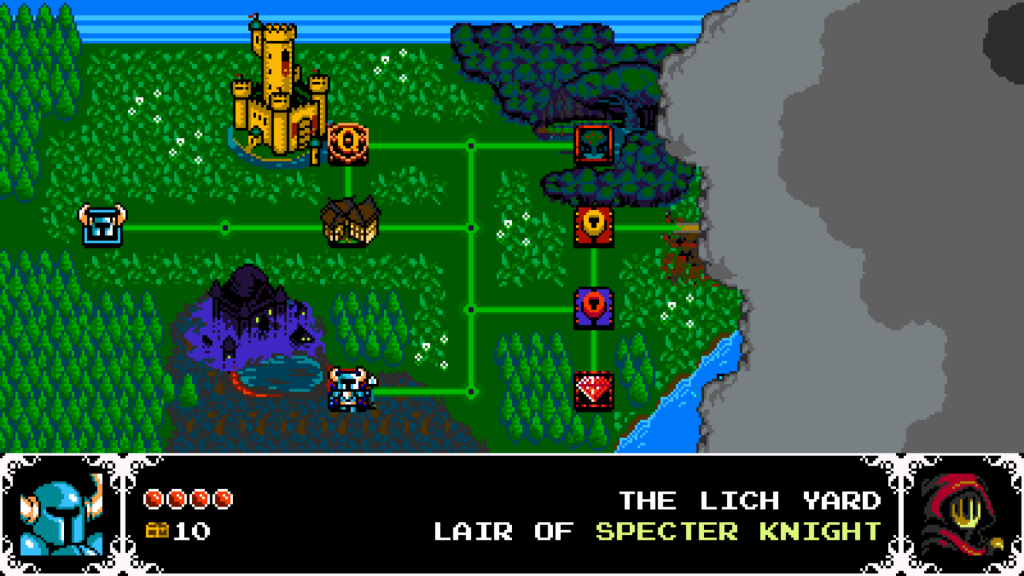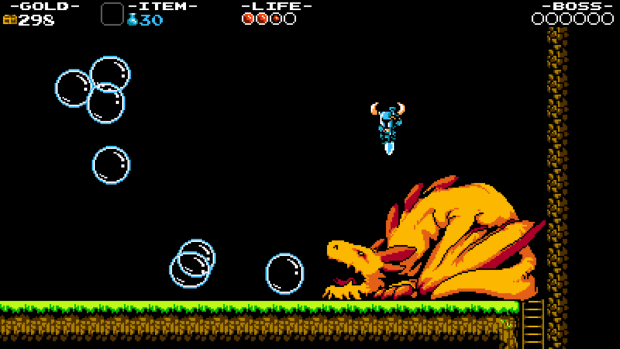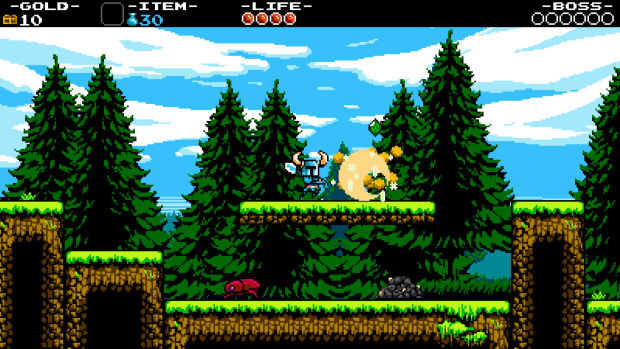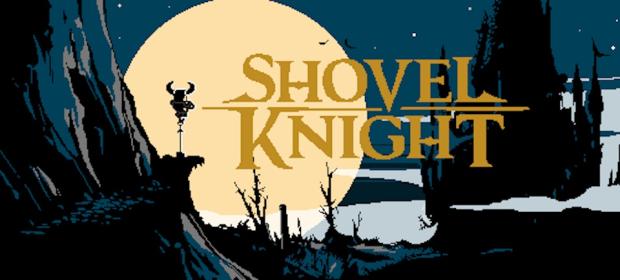Shovel Knight instantly encourages comparisons. Mega Man here, Castlevania there, Super Mario Bros 3 on the map; the town is a bit Zelda II, oh look you can pogo like in Duck Tales. But to talk about Shovel Knight purely in similarities does the game a huge disservice.
Not that it’s a bad thing to talk about Shovel Knight in reference to other titles. Doing so does succinctly outlines many of its components – it’s more that doing this and not then acknowledging Shovel Knight’s independent success is just simply rude.
So let’s get the comparison’s out of the way, shall we? Mega Man is the most key and obvious influence on Shovel Knight. You play a rather squat blue character as he traverses through stages themed after bosses, with each stage containing numerous platforming and combat challenges that are often unique and designed in a style specific to that level (as is expected of a great platform game). Some platform challenges feel identical to Mega Man, in fact, but the melee style combat and extra traversal techniques here (such as pogo-ing with your shovel off of an enemy’s nonce) give Shovel Knight some unique spice to distance it from being a direct rip off of the blue bomber.

As for Castlevania? Well, ignoring the instant thematic similarities with knights, necromancers, skeletons and the like, within each level is a relic. These relics, once found, can be used in combat and traversal, but will consume hearts as you use them, similar to Castlevania’s own sub weapons. What separates the relics from said sub weapons is that once you find one in Shovel Knight you can swap between them freely to give you an edge as and when you need it, like Mega Man’s suit powers. Smart relic use leads to smart play, but more on that later.
After making all of these retro references, I feel a need to point to one of Shovel Knight’s key ideas that will make the game more approachable should you not be the sort to enjoy 80’s style difficulty barricades. I don’t mean that Shovel Knight isn’t a hard game (making that point for those that do like their retro games to be solid), because it can certainly be challenging, but it’s got frequent checkpoints you see.

So while Shovel Knight may carry the hallmarks of some of gaming’s oldest heroes, it’s very much a game made in the here and now. Not only are checkpoints generous but the game has a nice, almost heartwarming narrative tone, too. Not award winning, but it’s a sincere tale and something you likely wouldn’t expect from a game so clearly born of gaming’s early days.
It’s simple: Shovel Knight is fighting back against an encroaching evil after finally coming to terms with the loss of his beloved Shield Knight in a previous scuffle – but the game goes a long way to make you want to care about his simple plight. Dream sequences in which you’re asked to try and save Shield Knight are quaint, endearing and, as said, something more sincere than you’d expect from such a retro fuelled title.
And just in case I’ve made the game sound soft don’t worry, Shovel Knight can be just as demanding as you want it to be. Similarly to other modern retro games such as Mega Man 9, Shovel Knight’s real teeth can be found in its achievement list (which is all in-game, in case you’re playing on Wii U/3DS).

Alongside simply playing the core levels, Shovel Knight contains extra challenges. These range from minor stages that put relics to interesting use, optional bosses that provide fresh challenge, and even some silly sub games and achievements that put your control of Shovel Knight to the test.
And if the game still isn’t tricky enough? Again, achievements have you sorted. Remember I mentioned those checkpoints? You can break them all, rendering them useless but dolling out some extra treasure (which can be used to buy upgrades), and one achievement asks you to finish the game breaking every one, essentially turning Shovel Knight into a true retro minded title. Another challenges you to finish the game in an hour and a half, pushing Relic knowledge to the limit. Yet another tasks you with finishing the game without picking up any relics, testing just how good you actually are with that basic shovel.

Of course all of this would be for nothing if Shovel Knight didn’t play well, so it’s fortunate that it’s incredibly well-designed. The knight controls beautifully, reacting to every nudge and twitch of the controls (though you’ll likely want something better than an Xbox 360 D-Pad if possible), and enemies and bosses alike are a pleasure to analyse, fight and beat. But more than that, the levels encourage replayability by being succinct but varied, and just entertaining to perfect.
Shovel Knight is a genuine success. While early play will entice comparisons due to its clear reverence of the past, the true mark of the game’s quality is that, upon completion, you’ll simply refer to it’s many levels, bosses, and ideas, as Shovel Knight. The wonderful modern retro classic, Shovel Knight.

SUPERB. This is the mark of greatness, only awarded to games that engage us from start to finish. Titles that score 9/10 will have very few problems or negative issues, and will deliver high quality and value for money across all aspects of their design.
Review code provided by developer.






